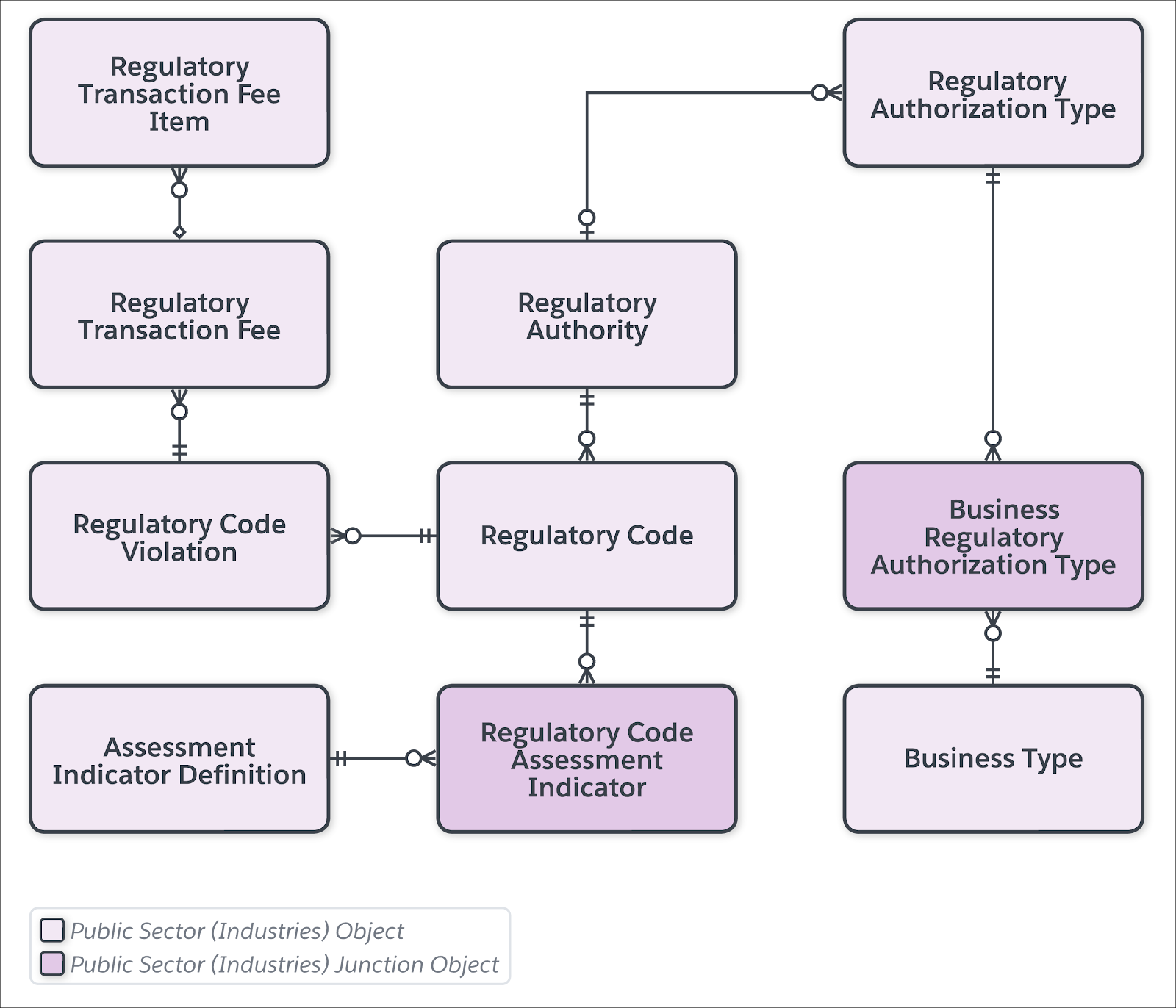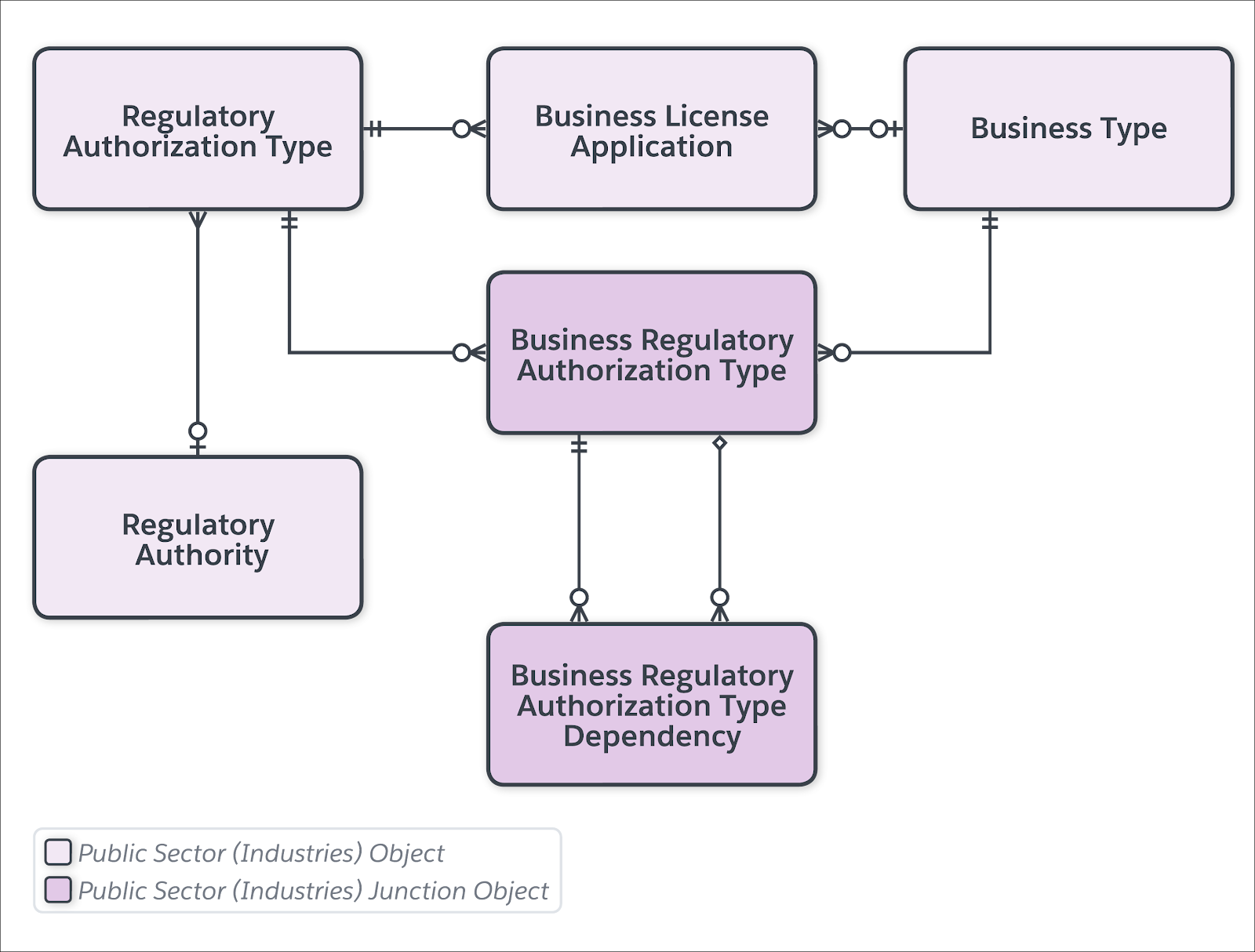Review Regulatory Authorities and Codes
Learning Objectives
After completing this unit, you’ll be able to:
- Explain what Regulatory Authority and Regulatory Code objects do.
- Describe the relationship between regulatory codes and assessment indicators.
- Describe business regulatory authorization type dependencies.
Explore Regulatory Objects
Government agencies issue licenses and permits based on certain requirements and regulations. Whether it’s a business license for a new salon or an individual’s fishing permit, every license and permit must meet certain requirements. Public Sector Solutions stores data about regulatory agencies and requirements in several objects. Let’s go through them, and then see how they’re used in Cosville.
The regulatory agencies that have the authority to issue licenses and permits are represented in the Regulatory Authority object. Every regulatory authority can grant different types of licenses and permits. In Cosville, for example, the Board of Barbering and Cosmetology (Regulatory Authority) issues establishment (business) licenses and (individual) hairdresser licenses.
In Public Sector Solutions, these different types of licenses are stored in the Regulatory Authorization Type object. Through the Business Regulatory Authorization Type junction object, every regulatory authorization type relates to a business type.
What about those requirements we mentioned a moment ago? Regulatory authorities grant licenses and permits based on applicable regulatory code. For example, every new business establishment—whether it’s a salon, a restaurant, or a clothing store—needs to meet fire safety requirements. Depending on the type of business, other regulations apply. A salon needs to safely store the chemicals it uses, while a restaurant needs to store food at proper temperatures. All of these requirements are represented as regulatory codes that are related to, and enforced by, regulatory authorities.
There are some other objects related to regulatory authorities and codes, representing assessment indicators, violations, and fees. We explore those objects more deeply in a bit.
Here's how the regulatory objects are configured in Cosville for Sunshine Salon (Account), which needs a business license to operate as well as a permit to put up a sign.
Objects |
Type of Relationship |
Details |
|---|---|---|
Regulatory Authority and Regulatory Authorization Type |
Lookup |
The Board of Barbering and Cosmetology (Regulatory Authority) grants an Establishment License (Regulatory Authorization Type) that Susan Adams (Contact), owner of Sunshine Salon (Account), needs to operate. It also grants a Sign Permit (Regulatory Authorization Type) that Susan needs so she can put up a sign to advertise the salon. |
Regulatory Authority and Regulatory Code |
Master-detail |
The Board of Barbering and Cosmetology (Regulatory Authority) enforces the Sanitation and Hazardous Chemicals Compliance code (Regulatory Code) for salons in Cosville. |
Regulatory Authorization Type, Business Regulatory Authorization Type, and Business Type |
The Business Regulatory Authorization Type junction object maps regulatory authorization types with the business types. |
Establishes a relationship (Business Regulatory Authorization Type) between Sunshine Salon's sign permit (Regulatory Authorization Type) and the business type Salon (Business Type). |
And here are some other examples of regulatory objects in Cosville's Public Sector Solutions org.
- The Board of Medicine (Regulatory Authority) issues a Physician's License (Regulatory Authorization Type).
- The Department of Motor Vehicles (Regulatory Authority) issues a Driver's License (Regulatory Authorization Type).
- The Department of Motor Vehicles (Regulatory Authority) enforces Standard No. 122: Motorcycle Brake Systems (Regulatory Code) and Standard No. 126: Electronic Stability Control Systems (Regulatory Code).
- The Department of Building Inspection and Fire Safety (Regulatory Authority) enforces Ch 01, Section 105.6.4 Carnivals, Fairs, Festivals, and Exhibitions (Regulatory Code).
Understand Assessment Indicators, Violations, and Fees
Earlier, we mentioned that Public Sector Solutions uses some other objects related to regulatory authorities and codes—objects that represent assessment indicators, violations, and fees. Let’s learn about those objects now.
When a regulatory authority processes a business license application, it often needs to determine whether the establishment complies with applicable regulatory code. But regulatory code is simply a requirement by a regulatory agency, such as 16 Admin. Code Ch. 83.114(a) of the Board of Barbering and Cosmetology Codes and Procedures, which states, “Every establishment shall provide at least one restroom located on or near the premises of the establishment. For public safety, chemical supplies shall not be stored in the restroom.”
This is where assessment indicators come in. They help inspectors determine whether the establishment meets the applicable regulatory code. In Cosville, for 16 Admin. Code Ch. 83.114(a), one assessment indicator is that a restroom is present onsite. The other is that no chemicals are stored in the restroom. Inspectors look for assessment indicators when they visit a site to check for code compliance.
If an establishment doesn’t meet an assessment indicator, the inspector records that as a regulatory code violation. Public Sector Solutions also includes the Regulatory Transaction Fee object, which defines fees for violations, and the Regulatory Transaction Fee Item object, which contains specific fee details.
The Cosville Board of Barbering and Cosmetology (Regulatory Authority), for example, levies a $500 fine (Violation Enforcement Action) when a salon fails to safely store hazardous chemicals onsite (Regulatory Code Violation). Regulatory transaction fees can also represent other kinds of fees, such as application fees, inspection fees, and licenses fees, not just fees for violations.
Don't worry, we go into more detail about inspections and violations in the next unit. Meanwhile, here’s a diagram that shows the regulatory objects and how they relate.

Learn About Authorization Type Dependencies
It’s all well and good if a constituent applies for just one license or permit, but what if they need more than one? It’s not uncommon for businesses to need multiple licenses to operate, and for government agencies to require that constituents apply for all of those licenses at once, or in a specific sequence.
Luckily, the regulatory authorization data model in Public Sector Solutions allows for multiple licenses through dependencies. The Business Regulatory Authorization Type Dependency object lets you define relationships between business regulatory authorization types. It relates all of the licenses or permits required to establish different types of businesses to reflect the order in which they're issued.
For example, you can relate all of the licenses and permits that restaurants need to operate. These include a business license, a food service license, a health permit, and, if they plan to serve alcohol, a liquor license. In this example, the business license is the parent license. And the applicant needs to get the food service and other permits and licenses before they can get the business license. Constituents can see all the required licenses and permits, including dependencies, for any type of business in your Experience Cloud portal. Intake officers and other Public Sector Solutions users can see them in the License and Permit Management app.
Here’s a diagram of the business regulatory authorization type dependency data model.

Let’s go back to Cosville, where they’re using business regulatory authorization type dependencies to require that constituents like Susan Adams apply for a sign permit along with her salon business license application. Here are details on the objects Cosville uses in this scenario.
Object |
Is Related To |
Details |
|---|---|---|
Business License Application |
Regulatory Authorization Type and Business Type |
Susan Adams submits the Sunshine Salon application (Business License Application) to request a business license to open her salon. |
Business Type |
Business License |
Salon is the type of business that Susan intends to operate. |
Regulatory Authority |
Regulatory Authorization Type |
The Board of Barbering and Cosmetology is the agency that issues licenses and permits to operate hair salons. |
Business Regulatory Authorization Type |
Regulatory Authorization Type and Business Regulatory Authorization Type Dependency |
Business License for Salon (parent) represents the association between Salon (Business Type) and the Salon Business License (Regulatory Authorization Type). Sign Permit for Salon (child) represents the association between the Salon (Business Type) and the Salon Sign Permit (Regulatory Authorization Type). |
You now have an understanding of the regulatory objects that Public Sector Solutions uses to evaluate license and permit applications. In the next unit, we'll look at the objects used for inspections.
